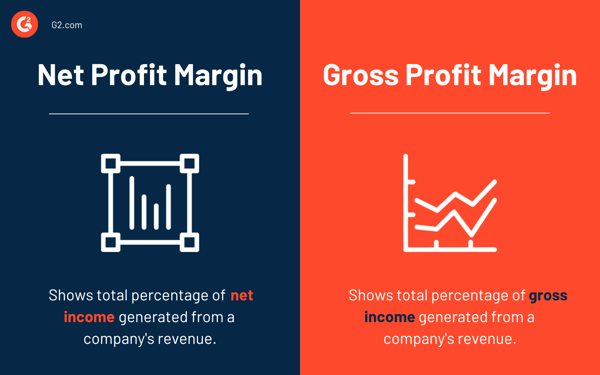

Each sales dollar you make leaves you some profit.
Of course, you pay operating expenses and taxes from this total sales revenue. What you have left is the profit margin that reveals your company’s financial health. If you run a big business, you can never calculate this net margin manually. That’s why business owners use accounting software to measure the net profit they make for every dollar of revenue.
Net profit margin measures the amount of net income or profit you generate from sales revenue. It reveals the percentage of net sales revenue you have after paying for operating expenses, amortization, income taxes, interest, and depreciation. It’s also known as net income margin, net margin, or return on sales ratio.
You could think of net profit margin as how much of each dollar of revenue is retained by the company after they’ve paid off total expenses—like interest expenses, taxes, paying employees, and raw materials. In short, the net profit margin is total earnings as a percentage of its revenue.
A positive net profit margin indicates a company's strong financial health. Similarly, a decreasing net profit margin signals the need to take a second look at current practices and forecast profits accordingly. Plus, net profit margin as a percentage makes it easy to compare the profitability of two or more companies.
The following components of a company's operation contribute to the net profit margin:
Net profit margin also reveals a company's ability to control operational and overhead costs. If your operating costs grow at a rate faster than revenue, the net profit margin will decrease. This is why investors use net margin for running financial analysis and making investment decisions. Companies with increasing net margins attract investors and see share price growth over time.
Net profit margin = (net income/revenue) x 100
where net income = revenue - COGS - operating expenses - interest - taxes
Net profit margin is calculated using a company’s net income and total revenue—all data that can be found on its financial statements. A company’s net income is its gross profit minus its cost of goods sold, or COGS. In the case of service-businesses, the net income is gross profit after deducting the service cost. Rather than calculating it, you can always find net income at the bottom of the income statement.
Once you know a company’s net income and revenue, plug them into the equation above to find the net profit margin.
Once you have a company’s income statement or balance sheet, use the following steps to calculate the net profit margin.
Tip: Net income is also known as the bottom line because it appears at the bottom of an income statement. Once you find the net income on an income statement, you can divide it by total revenue and multiply the result by 100 to get the net profit margin.
Let’s do a net profit margin calculation of two similar companies to see who is more profitable: McDonald’s and Wendy’s.
Mcdonalds
Even though McDonald’s net income is much higher than Wendy’s, their net profit margins are very similar. This means that even though one company is making more money than the other, they have similar profitability ratios, and Wendy’s, the smaller of the two, has a slight edge over McDonald’s when it comes to net profit margin.
This could be because McDonald’s pays their employees higher wages or because Wendy’s uses cheaper supplies. We don’t know for sure by this calculation; most likely, it is a combination of several factors.
Net profit margin varies depending on the industry and business size. The general rule of thumb is that a 10% net profit margin is average, a 20% margin is good, whereas a 5% margin is a low profit margin.
A higher net profit margin shows a company’s ability to control costs and sell products at prices higher than costs. A high profit margin is often an indicator of efficient operation management, low expenses, and efficient pricing strategies.
A low net profit margin reflects a company’s poor pricing strategy and inefficient cost structure.
Net profit margin is a more accurate measurement of a company’s overall profitability.

Gross profit margin tells you the gross margin of a company without accounting for taxes, COGS, interest, or other expenses. You can calculate the gross profit margin by dividing the gross profit by the total revenue.
Net profit margin as a metric faces different issues.
Sometimes, you’ll also see companies reducing discretionary business expenses (equipment maintenance, research and development, marketing, etc.) to increase the net profit margin. That’s why it’s best to consider different financial ratios and metrics before investing in a company.
Instead of getting carried away with big numbers and gross profits, a simple calculation to find a company’s net profit margin can give you a more realistic picture of how a company is doing. It’s the least investors and entrepreneurs can do to learn about profitability. However, if you’d rather not calculate the financial metrics yourself, investment portfolio management software can help.
Maddie is a former content specialist at G2. She also has a passion for music and cats. (she/her/hers)
You walk into your office Monday morning and spy a colleague enjoying a powdered donut.
 by Maddie Rehayem
by Maddie Rehayem
Wouldn’t it look strange if there was no space between the edge of a page and the text?
 by Emily Goorevich
by Emily Goorevich
“So, what are you going to do with your life?”
 by Mara Calvello
by Mara Calvello
You walk into your office Monday morning and spy a colleague enjoying a powdered donut.
 by Maddie Rehayem
by Maddie Rehayem
Wouldn’t it look strange if there was no space between the edge of a page and the text?
 by Emily Goorevich
by Emily Goorevich
Never miss a post.
Subscribe to keep your fingers on the tech pulse.


